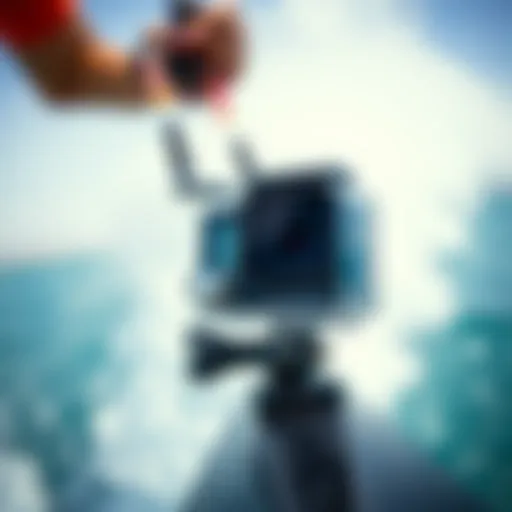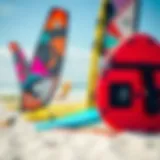The Small Hydrofoil in Kiteboarding: Design and Impact
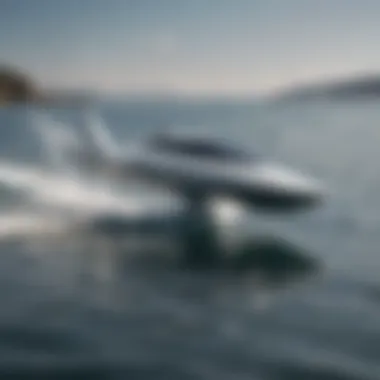

Intro
When we think about the thrill of kiteboarding, one element silently aids in amplifying the excitement: the small hydrofoil. This handy piece of technology is revolutionizing how enthusiasts navigate the water, making it not just a sport, but an experience that blends art and performance. Hydrofoils lift the board above the water, reducing drag and allowing riders to glide seamlessly across the surface. This article will unpack what hydrofoils do, how they're designed, the materials that make them tick, and their broad impact on the sport.
Understanding small hydrofoils is more than a technical endeavor; it's about grasping how they can transform your kiteboarding experience. From casual riders splashing along the shore to seasoned athletes executing breathtaking maneuvers, small hydrofoils offer something for everyone. In the following sections, we'll dive deeper into gear insights, techniques, and tips that elevate your time on the water. This is not merely an exploration of equipment—it's a journey to mastery.
Gear Insights
Latest Gear Reviews
The landscape of hydrofoils is expanding rapidly. There are new players entering the market and established brands continuously innovating. One product that stands out is the Lift Foils Hydrofoil, known for its remarkable blend of stability and speed. With an exceptional design that caters to both beginners and seasoned riders, this hydrofoil has captured attention for good reason. Its adaptable features allow for smooth transitions between learning and advanced maneuvers, making it a solid choice for a wide range of kiteboarders.
Another commendable option is the Naish Hover Series. These foils are renowned for their impressive material quality, providing durability while maintaining a lightweight structure. Such characteristics are vital for kiteboarders aiming to reduce fatigue during longer sessions on the water. Both of these choices highlight how technology and design converge to enhance performance and, ultimately, enjoyment.
Essential Gear for Beginners
If you’re new to the world of kiteboarding, selecting the right gear can be overwhelming. It’s crucial to start with equipment that fosters confidence and comfort. The HQ Hydra Foil is an excellent entry-level option. Its stable design diminishes the chance of wipeouts, which can dissuade newcomers. Paired with an adaptable kite, beginners can gradually gain proficiency without feeling the pressure of advanced gear.
Additionally, consider having safety equipment, such as a helmet and impact vest. These items can make a significant difference in the event of unexpected falls. Remember, it’s about enjoying the ride, but safety should never take a backseat. With the right selections in hand, newcomers will find themselves better equipped to master the art of kiteboarding.
"The right gear acts like a trusty sidekick, making the adventures in kiteboarding not just safer, but more enjoyable."
Techniques and Tips
Advanced Tricks and Techniques
Once comfortable with basic maneuvers, the transformation that a hydrofoil brings opens doors to advanced tricks. A common progression includes learning to perform a jump-to-foiling where riders can leverage their kite’s pull to leap into the air and land back on the foil gracefully. Mastering this requires not just timing but also an understanding of how the foil reacts to different speeds and angles.
Another thrilling trick is the downloop, which involves looping the kite while in the air. The momentum helps in maintaining speed as the rider transitions back onto the water. Practicing these tricks in flat water allows beginners to refine their skills without waves complicating the mix.
Safety Practices for Kiteboarders
While the allure of speeding across the waves is undeniable, safety should always reign supreme. Wearing a life vest and a helmet, especially in choppy waters, can be a lifesaver. Moreover, one seasoned trick is to always kite with a buddy or at least inform someone on land where you plan to be.
Practicing self-rescue techniques is equally essential. Familiarize yourself with how to control your kite, even when you’re off the board. This awareness can prevent accidents, especially in busy waters. An informed kiteboarder is a capable kiteboarder, paving the way for fulfilling and safe adventures.
As technology continues to elevate the sport, the integration of small hydrofoils into kiteboarding marks a significant shift. With thoughtful consideration of gear choices, strategic technique practice, and unwavering commitment to safety, kiteboarders can unlock potential that goes beyond what they ever imagined.
Intro to Small Hydrofoils
Understanding the world of small hydrofoils is pivotal for anyone keen on advancing their kiteboarding skills or simply grasping the new dynamics of the sport. Small hydrofoils bring a unique blend of functions and designs that greatly enhance maneuverability and performance. They raise the game, allowing riders to glide effortlessly above the water's surface, significantly improving speed and stability while minimizing drag. For seasoned kiteboarders and newcomers alike, appreciating these benefits goes hand in hand with recognizing the considerations that come with adoption and use of hydrofoil technology.
Defining Hydrofoil Technology
Hydrofoil technology can be described as a system where a specialized wing or foil is submerged underwater, generating lift and letting the board rise above the water's surface. This reduces the overall resistance felt during boarding, allowing for snappier turns and accelerated speeds.
In simpler terms, it’s like giving your kiteboard a pair of wings. As the rider picks up speed, the water flows over the foil, creating a pressure difference that lifts the board. This technology has a few vital terms tied to its mechanics:
- Lift: This is the upward force created by the foil as a rider accelerates. Think of it as the magic that makes the board rise out of the water.
- Drag: In contrast, drag is the resistance faced by the board in motion, which is lessened significantly thanks to the hydrofoil.
- Stability: A well-designed hydrofoil keeps the board stable even in choppy waters, making for a smoother ride.
Understanding these fundamentals sets the stage for deeper exploration into how small hydrofoils affect kiteboarding experiences.
Historical Context and Evolution
The journey of hydrofoils traces back decades, with early experiments in the 19th century laying the groundwork for today’s technology. Initially, hydrofoils were seen in various marine vessels, focusing on speeding up boats and enhancing their efficiency. Each iteration added layers of sophistication, leading to more precise control and efficiency.
Fast-forward to the late 20th century, where windsurfing enthusiasts began to tinker with small hydrofoils. Riders found they could perform incredible maneuvers while enjoying faster speeds. This experimentation resulted in a new wave of design that caught the eye of the kiteboarding community.
By the 2000s, innovations in materials and construction techniques turned hydrofoils into a common sight in kiteboarding. Today, manufacturers are constantly reevaluating designs and experimentation that push the limits of what's possible. Riding a hydrofoil has become a sought-after experience, promising both thrill and adventure like few other activities in watersports.
As we delve deeper into the mechanics and design of small hydrofoils, the ongoing evolution of this technology underscores its importance in shaping the modern kiteboarding landscape.
"Innovation and adaptation have always been key in the watersports world, where the right equipment can change everything."
Principles of Hydrofoil Mechanics
In kiteboarding, the principles governing hydrofoil mechanics are the backbone of the experience. Understanding these concepts not only enhances performance but informs decision-making when it comes to gear and riding style. With a hydrofoil, the interaction between the board, the water, and the kite opens up a world of dynamics that can dramatically change how you ride.
Lift and Drag Forces
Lift and drag forces play fundamental roles in the mechanics behind hydrofoils. Lift is the upward force that allows the hydrofoil to ascend above the water surface, while drag is the resistance that the foil encounters as it moves through the water. By cleverly balancing these forces, riders can achieve greater control and enhanced speed.
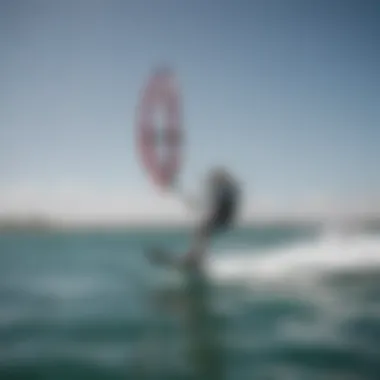

When the kite generates power, it pulls the rider forward. The hydrofoil's shape, notably the angle of attack and its design, is what ultimately dictates whether lift is maximized or minimized. For instance, an appropriately angled foil can create significant lift at relatively low speeds, allowing the rider to glide effortlessly over the water surface. Conversely, if the angle is incorrect, it may result in excessive drag, causing inefficient movement or even a sudden drop back into the water.
Experts often suggest that riders should experiment with different foil profiles and adjust their riding styles accordingly. This hands-on approach is crucial for understanding how lift and drag interact—each attempt offers valuable insights into personal performance optimization. The fine-tuning of these forces is a dance; the right balance can make a good rider feel like a pro.
Hydrodynamics in Kiteboarding
Hydrodynamics is a specialized field, influencing everything from the shape of the foil to how the rider interacts with it. When the hydrofoil moves through the water, the flow of liquid creates patterns that can significantly affect performance. A key aspect of hydrodynamics in kiteboarding is understanding the water's movement around the foil, characterizing how it behaves under different speeds and angles.
A well-designed hydrofoil harnesses hydrodynamic principles to minimize resistance and maximize lift, leading to smooth and efficient riding. For example, the curvature of the wings can be optimized for both lift and stability. Riders often notice that foils with a pronounced camber provide better lift at lower speeds, making them ideal for light wind conditions. Meanwhile, flat profile foils are adept at cutting through the water at higher speeds, making bursts of acceleration feel almost effortless.
"It's not just about getting up on the foil; it's about understanding how water moves around it that separates the average rider from the exceptional."
As you delve deeper into the mechanics of hydrofoils, you'll find that the interplay of hydrodynamics, lift, and drag is a continuous learning curve. Each session on the water provides insights into how your equipment responds and how slight adjustments can enhance your overall kiteboarding experience.
Design Aspects of Small Hydrofoils
Designing a small hydrofoil for kiteboarding is no simple matter. There are several factors that can influence not only performance but also safety and usability. Understanding these design aspects is paramount for both manufacturers and riders to maximize the potential of this technology. Each choice made during the design process impacts how a hydrofoil operates, how it interacts with water, and ultimately, how a kiteboarder experiences the ride.
Foil Shape and Size Considerations
The shape and size of a hydrofoil greatly affect its performance in the water. Typically, a hydrofoil consists of two main parts: the wing and the fuselage. The shape of the wing contributes to lift and drag, both of which are crucial in hydrofoil dynamics. A larger surface area can provide more lift but may also increase drag, while a smaller wing is faster through the water but can stall more easily under certain conditions.
- Aspect Ratio: This refers to the ratio of the wing's length to its width. Higher aspect ratios enhance speed and efficiency, which is ideal for advanced riders seeking high performance. However, they might sacrifice stability during turns. Riders need to think about what kind of kiteboarding they plan to do most often when choosing this.
- Wing Shape: A longer, narrow wing shape is generally better for speed, while a wider wing aids in stability and lift. For beginner kiteboarders, a wider foil can provide a more forgiving ride, making it easier to learn before progressing to more advanced options.
Different designs cater to various riding styles too. For example, a foil designed for aggressive maneuverability might have a more curved profile to allow for quick turns, while a flatter design could be more suited for speed enthusiasts.
Materials Used in Construction
The materials chosen for hydrofoil construction can significantly impact weight, strength, and durability. Typically, manufacturers have the following options:
- Carbon Fiber: This is a popular option in high-performance hydrofoils due to its lightweight and rigidity. Carbon fiber is pricy, but it gives advanced riders the edge they desire. Its stiffness translates to better power transfer and responsiveness.
- Aluminum: A more budget-friendly alternative that still offers decent strength and stability. While slightly heavier than carbon fiber, aluminum provides good durability, making it a solid choice for those new to the sport.
- Foam Cores: Seen in some boards and hydrofoils, foam cores can reduce weight significantly, making them easier to handle, especially in rough waters. However, they may not be as robust as solid materials and can be prone to damage.
"When designing a hydrofoil, balance is key. It's about marrying shape, size, and materials to optimize performance for varying skill levels."
This understanding not only elevates the riding experience, but it turns kiteboarding into a personal and unique adventure.
Performance Attributes
In the world of kiteboarding, performance attributes are pivotal to the excitement and efficiency of riding. Small hydrofoils not only enhance speed but also improve maneuverability and stability. Each of these attributes plays a crucial role in defining the all-round experience for both novices and seasoned riders. Understanding these performance aspects allows enthusiasts to make informed choices and truly appreciate what a hydrofoil adds to their kiteboarding escapade.
Speed and Acceleration
Speed is often the first thing that comes to mind when discussing hydrofoiling. With small hydrofoils, riders can achieve remarkable speeds, especially when compared to traditional methods of kiteboarding. The hydrofoil lifts above the water's surface, significantly reducing drag. This means less resistance and the ability to cruise effortlessly even in light winds.
A practical example can be seen in the case of a rider who switches from a conventional board to a hydrofoil. While they might have struggled to catch air and maintain pace, using a hydrofoil can change the game entirely. The smooth glide over the water opens up new realms of potential speed, providing an exhilarating rush as the rider zips across the surface.
- Increased Lift: The foil's design allows for more lift at lower speeds, making it easier to get up and going swiftly.
- Wind Utilization: More efficient riding means better use of varying wind conditions, maximizing speed.
As some refer to it, "the world is your oyster" with a hydrofoil; riders can explore distances they hadn't imagined before, zooming past those still tethered to the more traditional boards.
Stability and Control
Stability is another dimension where hydrofoils shine. Once airborne, small hydrofoils help maintain a consistent flight path, allowing riders to focus on their performance instead of constantly battling for balance. The design is critical here. A well-constructed hydrofoil offers a combination of rigidity and flexibility, ensuring the rider can make subtle adjustments without losing control.
This stability becomes exceedingly crucial, particularly in choppy waters or under varying wind conditions. Riders find that they can maintain power while performing tricks or simply enjoying a longer ride without the oppressive fear of falling off. A rider accustomed to a conventional board may be surprised at how confidently they can traverse waves with a hydrofoil.
- Effective Feedback: Good hydrofoils give direct feedback through various conditions, making it easier to gauge performance and adjust accordingly.
- Enhanced Confidence: With stable rides, beginners often become more daring, trying tricks they wouldn’t have considered before.
"Once you experience stability with a hydrofoil, it feels like you’ve discovered an edge over the rest," said an experienced kiteboarder.
Turning Capabilities
When it comes to turning, the ability to shift dynamics rapidly is essential, especially in wave riding or navigating tight spots. In comparison to traditional boards, small hydrofoils allow for sharper and more controlled turns. The design of the foil can influence how a rider maneuvers through the water. A well-crafted hydrofoil can pivot with ease, responding quickly to the rider's input.
Many kiteboarders have noted that small hydrofoils enhance their ability to carve through waves, making for exhilarating experiences. Instead of relying solely on body movements, the hydrofoil's responsiveness amplifies the rider's intentions, leading to a more agile experience.
- Tailored Turns: Foils can be designed with specific turning radii, accommodating everything from casual rides to high-octane performances.
- Easy Transitions: Riders frequently remark on how seamlessly they can switch from aggressive maneuvers to slow, casual turns, enhancing the overall experience.
Hydrofoil Types and Configurations
Understanding hydrofoil types and configurations is essential for kiteboarders looking to maximize their potential on the water. Each type of hydrofoil comes with unique characteristics that cater to different riding styles, skill levels, and environmental conditions. This section dives into the intricacies of these hydrofoil types and how they can impact your overall kiteboarding experience.
Foils for Advanced Riders
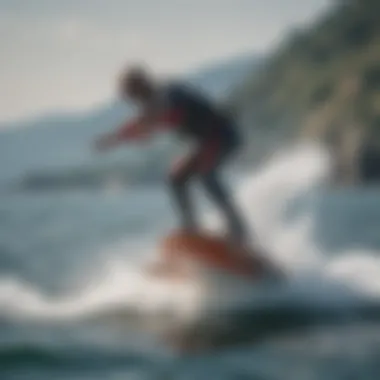

For advanced riders, hydrofoil selection is often predicated on high performance and agility. These foils are designed with precision to enable sharp turns, quick acceleration, and responsive handling. Typically, advanced models feature a smaller wingspan and a thinner profile, allowing them to cut through the water efficiently.
Some key elements to consider for advanced hydrofoils include:
- Wing Shape: Advanced foils often possess an asymmetric wing shape that enhances lift and reduces drag. This shape allows skilled riders to maintain speed even in choppy conditions.
- Stiffness and Flexibility: A stiffer hydrofoil design translates into better control during high-speed maneuvers, making it easier to maintain composure during challenging tricks.
- Height of the Foil: Experienced kiteboarders might prefer a higher aspect ratio, which allows for smoother riding at speed and the capability to leap into air.
Ultimately, advanced riders should prioritize their desired riding style and the conditions they typically encounter when selecting a hydrofoil. Whether it’s speedy flat waters or challenging waves, there’s a hydrofoil configuration out there that will meet their needs.
Beginner-Friendly Options
For those just starting out in the kiteboarding scene, choosing the right hydrofoil can be a bit daunting. However, beginner-friendly options are designed to offer stability and ease of use, making the learning process smoother. These foils usually have greater surface area and a more forgiving geometry, which helps maintain lift at lower speeds.
Considerations for beginner-friendly hydrofoils include:
- Wider Foil Design: A wider surface area increases stability, crucial for new riders who are still learning to balance on the board.
- Lower Aspect Ratio: These foils typically have a lower aspect ratio, which provides a consistent lift without the need for precise riding techniques. This can make the learning curve less steep.
- Durability and Construction: Beginners might benefit from hydrofoils built with tougher materials that can withstand a few bumps and knocks. This helps alleviate concerns of costly damages while learning to ride.
- User-Friendly Features: Many beginner foils come with adjustable settings that enable riders to modify the foil’s performance as their skills improve.
In summary, the choice of hydrofoil type and configuration can vastly influence the kiteboarding experience, shaping both performance and comfort on the water. For kiteboarders at any level, selecting the right kind of foil based on personal skill, riding style, and conditions is critical to enjoying the thrill and freedom that comes with this beloved sport.
"The right gear won’t make you a pro overnight, but it sure can smooth the journey to better riding!"
As you explore various hydrofoil types, consider how they align with your goals as a kiteboarder, and don’t hesitate to seek guidance from experienced riders in your community.
Integration with Kiteboarding Gear
The integration of small hydrofoils with kiteboarding gear significantly impacts the overall experience of riders, enhancing both performance and maneuverability in a variety of conditions. Understanding how these elements work in synergy is essential for both new and seasoned kiteboarders, as it not only affects riding styles but also informs choices when it comes to gear selection. Being equipped with the right information can mean the difference between a smooth ride and a frustrating day on the water.
Choosing the Right Kite for Hydrofoil Use
Selecting the appropriate kite is crucial when utilizing a hydrofoil. The kite’s size and type can greatly influence lift, control, and responsiveness. Here are some factors to consider:
- Kite Size: Generally, smaller kites are favored for hydrofoiling. They provide better control while minimizing drag, especially in high winds. However, in lighter winds, a larger kite may be necessary to generate sufficient power.
- Type of Kite: Freeride kites, known for their versatility, are often ideal for hydrofoiling. They offer stable flight and easy handling which is beneficial when learning to foil. On the other hand, wave kites can be used for more experienced riders seeking performance in challenging conditions.
- Aspect Ratio: A higher aspect ratio kite will provide less drag, which allows for a more exhilarating ride when hydrofoiling. These kites also assist in maintaining speed, making them suitable for advanced maneuvers during kiteboarding.
Choosing the right kite involves considering the conditions you’ll be riding in. For instance, a rider anticipating choppy waters may lean towards a kite that’s known for stability rather than one that excels in speed.
Board Compatibility
The board you select to pair with your hydrofoil setup also plays a pivotal role. Compatibility between the board and hydrofoil is not just about fitting; it affects performance characteristics such as style of riding and ease of use.
- Board Size and Shape: A board tailored for hydrofoiling typically has a flatter shape with a wider fuselage than standard kiteboards. This design allows for proper lift when the board is in the air. Smaller boards may fit more advanced riders who appreciate agility, while larger boards are often more forgiving and thereby suitable for beginners.
- Mounting System: Inspect the mounting system of the board carefully. Most hydrofoil boards have specific mounting spots where the foils attach. Ensuring that your foil matches with the board's mount is critical; misalignment can lead to instability and can be hazardous.
- Material Considerations: Some boards are made from lightweight materials, which is advantageous for quicker take-offs; however, they might be less durable in the long haul. Selecting a board constructed of high-grade materials will ensure longevity and performance.
In summary, by meticulously considering kite and board compatibility with small hydrofoils, riders can enhance their performance on the water. As you gear up, remember that every component interconnects to provide a seamless riding experience.
"The right equipment can transform the water into your playground."
Integrating small hydrofoils, kites, and boards not only elevates your kiteboarding skills but also enriches your adventure on the waves. When well-matched, these elements can create a thrilling synergy that augments your connection with the water.
Safety Considerations
In any sport, ensuring the safety of participants is paramount, and kiteboarding is no exception. The unique dynamics introduced by hydrofoils add another layer to consider. As kiteboarders glide above the water’s surface, a robust understanding of safety precautions is essential. This section discusses the specific hydrofoil risks and outlines best practices to mitigate them, ultimately enabling a safer and more enjoyable riding experience.
Hydrofoil-Specific Risks
Riding a hydrofoil presents distinct challenges that are not found in traditional kiteboarding. Firstly, the height the rider attains above the water can lead to potential falls that occur from a considerable distance. Consider the situation when you lose balance while trying a trick. The impact isn’t just some wet splash; it can lead to serious injuries if not properly managed.
Some additional risks include:
- Collision Risks: Hydrofoils can be particularly sharp, and if a rider falls or comes too close to another, there’s a danger of cutting or injuring someone else.
- Equipment Entanglement: The lines used in kiteboarding can sometimes get tangled in unstable situations. This may hinder the ability to release and can lead to accidents.
- Environmental Factors: Unpredictable waves and wind can quickly throw even the most experienced riders off balance, leading to falls or crashes.
Therefore, it’s crucial for riders to be fully aware of these risks before hitting the water. Staying alert and disciplined is the name of the game in avoiding mishaps.
Best Practices for Safe Riding
To enhance safety while riding hydrofoils, several guidelines can be adhered to that blend into a clear strategy for enjoyable kiteboarding experience. Here are some tried-and-true practices:
- Wearing Proper Safety Gear: Always equip yourself with a helmet and impact vest. These can cushion impacts significantly, reducing injury severity.
- Thorough Equipment Checks: Before every session, ensure all your gear is functioning properly. A small oversight can lead to disastrous consequences.
- Practice in Safe Environments: Start in locations with minimal obstacles and genteel water conditions. This gives you room to learn the ropes without worrying about colliding with rocks or crowds.
- Understand Your Hydrodynamics: Familiarize yourself with how your body moves on the hydrofoil and simulate different conditions during training. Calm water environments can help develop confidence before encountering choppy waves.
- Communicate with Others: If you’re riding in a crowded area, signal to other kiteboarders and stay aware of their positions. Avoiding unexpected interactions can prevent accidents.
- Take Lessons: If you’re new to hydrofoiling, consider taking lessons from an experienced instructor. They can provide tailored tips and strategies to help you understand movement safely.
"Preparation and awareness can turn what could be perilous encounters into just another ride in the surf.”
By integrating these practices into your routine, not only do you enhance your safety, but you also foster a culture of responsibility and awareness within the kiteboarding community. Keeping safety at the forefront will ensure that kiteboarding with a hydrofoil remains an exhilarating, yet secure, pursuit.
Trends in Hydrofoil Development
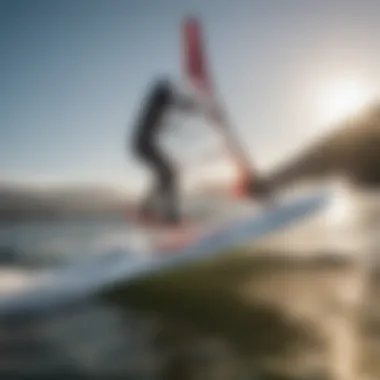

In the domain of kiteboarding, the trends in hydrofoil development are an integral part of optimizing performance and enhancing the overall experience. These trends are not only about the technical aspects but also how they reshape the way enthusiasts engage with the sport. From innovative design techniques to evolving materials, the continuous development translates into improved ride quality, accessibility, and sustainability.
Innovative Design Trends
One thing becomes clear when looking at the recent designs in hydrofoils: creativity and functionality go hand in hand. Kiteboard designers are increasingly experimenting with shapes that cater to specific riding styles. For instance, sharper leading edges and thicker foil sections provide better lift at lower speeds, making it easier for beginners to step into hydrofoiling without fear.
- Asymmetrical Foils: This trend has gained traction. Asymmetrical hydrofoils offer unique advantages in terms of agility and responsiveness during turns. This shape allows riders to perform sharper maneuvers, capitalizing on how water flows over different surfaces.
- Modular Designs: Increasing customization options play a huge role nowadays. Modular hydrofoils enable riders to swap out components, allowing for personalized setups based on their skill level and riding conditions. The modular approach not only enhances performance but also extends the lifespan of gear.
"The beauty of hydrofoil design today is that you can customize it to feel just right for your style. The adaptability is revolutionary."
Future Possibilities in the Sport
Looking ahead, the possibilities within hydrofoil technology are exciting. The integration of smart technology stands out as a significant trend that could change the game entirely. Imagine having sensors embedded in the foil to provide real-time data on speed and wind conditions! This tech could help riders refine their skills and enhance safety measures.
- Sustainability Focus: As the world shifts towards greener practices, the push for sustainable materials in hydrofoil construction is gaining momentum. Innovations like bio-composites and recycled materials are starting to appear in manufacturing processes, thus lessening ecological impacts.
- Enhanced Training Footwear: Another intriguing trend involves the development of specialized footwear designed for kiteboarding enthusiasts. These shoes can provide improved grip and better energy transfer during rides. With options designed specifically for hydrofoil setups, they will take comfort and performance to new heights.
Ultimately, these innovations aren’t just about the gear; they reflect a broader shift in the kiteboarding community towards a smarter, more adaptable sport. [Bolder designs, technology, and sustainability are paving the path for the future of hydrofoiling, making it accessible and enjoyable for all riders, novices and experts alike.]
Environmental Impacts
In today's world, where environmental considerations are paramount, understanding the impact of hydrofoil production on the ecosystem becomes crucial. As kiteboarding with small hydrofoils gains popularity, it is essential to evaluate the sustainable practices involved in their creation and use. This section will delve deeper into two significant aspects: sustainability in hydrofoil production and ways to mitigate ecological footprints associated with this exciting sport.
Sustainability of Hydrofoil Production
The process of making small hydrofoils often involves materials such as carbon fiber, fiberglass, and aluminum. Each of these materials brings its own set of environmental challenges. For instance, carbon fiber, although light and strong, requires considerable energy to produce and can lead to significant carbon emissions. Recycling options for carbon fiber aren't straightforward, which is a concern for eco-conscious riders.
On the other hand, aluminum is widely recyclable and has a lower environmental impact in terms of disposal compared to carbon fiber. Innovations are happening, though, as some manufacturers are looking at eco-friendly materials and methods to produce hydrofoils. This includes using sustainably sourced wood in some foil designs or exploring biodegradable resins for coatings. This shift towards more sustainable practices not only benefits the environment but may also appeal to a growing demographic of environmentally aware consumers.
Mitigating Ecological Footprints
When kiteboarding enthusiasts begin to learn how to ride a hydrofoil, they may not think about the environmental consequences of their actions. However, there are several steps that riders can take to lessen their ecological footprints:
- Choice of Locations: Opt for sites that have minimal environmental disturbance. Avoid areas where marine life is sensitive, such as breeding grounds or coral reefs.
- Respecting Nature: Follow guidelines for preserving natural habitats. For example, avoid cutting through grass beds or marshlands while launching or landing.
- Efficient Gear Management: Maintaining hydrofoils and keeping them in top condition extends their lifespan, which means fewer replacements. Regular checks for wear-and-tear can save resources.
- Consider Second-Hand Options: Buying used gear not only saves money but reduces demand for new production. It's a step toward greater sustainability.
"Every small change makes a difference, and kiteboarding doesn't have to come at the cost of our planet."
Ultimately, the kiteboarding community has a role to play in ensuring that their passion for the sport doesn't inadvertently harm the very environments they enjoy. As the sport evolves, embracing sustainable practices and lowering ecological footprints can lead to a more harmonious relationship with nature.
User Experience and Community Perspectives
Understanding the user experience and community perspectives is critical when it comes to small hydrofoils in kiteboarding. The insights gathered from enthusiasts and riders not only shape product development but also influence the overall culture of the sport. Engaging with this community helps identify trends, highlight benefits, and create a more inclusive environment for both novices and seasoned riders.
Voices from Enthusiasts
Riders often share their experiences in forums and social media, where the dialogue around hydrofoils is lively. On platforms like Reddit or Facebook, users voice their triumphs and challenges, creating a treasure trove of knowledge. Through real-life stories, novice kiteboarders gain practical tips and a sense of belonging in a community that can be both intimidating and welcoming.
- Shared Trials and Successes: Enthusiasts openly discuss gear that worked—and didn't work—for them. They speak candidly about their experiences on various types of hydrofoils. These discussions can guide new riders to make choices based on actual performance rather than on marketing hype.
- Personal Stories: Emotional connections play a big role. Stories about overcoming fears or those perfect moments when everything clicked, resonate deeply. Hearing about this journey can motivate others to persevere.
- Event Participation: Community events allow riders to test out new gear, share experiences, and learn from each other. It's in these gatherings that passionate discussions foster deeper understanding of hydrofoil riding techniques, adjustments, and preferences.
Active voices from within this community highlight the importance of support. When riders discuss their preferences, they often mention how that support allowed them to enhance their skills and ultimately their enjoyment of the sport.
Tutorials from Experienced Riders
The wealth of knowledge provided by experienced riders significantly enhances the learning process for those new to hydrofoiling. Tutorials focus on practical skills, insightful tips, and personal methods that seasoned kiteboarders have developed over time. This information is often shared through online videos, personalized blogs, or in-depth classes offered in local kiteboarding schools.
- Video Tutorials: Many riders upload videos that show specific techniques. This visual aid helps others understand the nuances of hydrofoil control, including how to balance and position oneself while riding. For instance, a video can clarify complex maneuvers, making them more digestible for beginners.
- Step-by-Step Guides: Written guides accompany video content and include detailed explanations. These guides often break down complicated aspects into simple steps, making them accessible even for those without prior experience.
- Community Workshops: Participating in workshops can give riders practical insights from mentors. These events often include hands-on training sessions where riders can refine their skills under the watchful eye of seasoned professionals.
"Learning to use a hydrofoil is like learning to ride a bike – you will fall a few times, but persistence pays off in joy and exhilaration."
The importance of user experience and community perspectives in the realm of small hydrofoils cannot be overstated—it layers the technical understanding of kiteboarding with the rich, lived experience of those who practice it daily. These insights not only enrich the sport but also bolster the confidence of newcomers, providing a foundation that guides them through the waters of both challenges and triumphs.
End
In wrapping up our discussion on small hydrofoils, it's essential to underscore their significant impact on both the mechanics and culture of kiteboarding. These innovative devices have propelled the sport into new heights, quite literally, offering riders a distinct advantage in performance and maneuverability.
Summarizing Key Points
As we’ve explored throughout this article, several key elements emerge regarding the small hydrofoil's contributions:
- Enhanced Performance: The ability to glide above water reduces drag significantly, allowing for greater speeds and acceleration, which can be a game changer in competitive environments.
- Technical Design Nuances: The variations in shape, size, and materials used in hydrofoils play a crucial role in their effectiveness. Every element must be meticulously considered to suit individual rider preferences and skill levels.
- User Experience: Perspectives from seasoned riders reveal a community that is not only passionate but also continuously evolving with new techniques and insights that enrich the sport.
- Sustainability Concerns: As the popularity of hydrofoils surges, there’s a pressing need to address the ecological impacts and emphasize sustainable practices in production and riding.
These points collectively illustrate how integral small hydrofoils have become to the kiteboarding scene, influencing everything from rider performance to environmental stewardship.
Final Thoughts on Hydrofoil Riding
While the allure of hydrofoil riding is undeniable, especially with adrenaline-fueled glides and seamless turns, it also calls for a serious commitment to mastering the craft. Riders must understand their equipment intimately, and continuous learning is part of the journey.
Combine that with a respect for the environment and fellow riders, and one sees that hydrofoils aren't just tools of the trade; they're gateways to a vibrant and dedicated community of kiteboarding enthusiasts. Whether you're a newcomer or a seasoned pro, the times ahead in hydrofoiling look bright and full of promise. As the sport continues to grow and innovate, each ride can bring something fresh and exciting, adding depth to the overall experience.
Remember, riding with a hydrofoil isn’t just about cutting through water; it's about carving out your own path in the world of kiteboarding.





